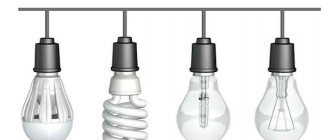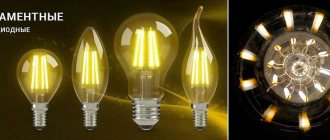Do you know why LED lights stay on when the switch is off? Agree: problems in the functioning of the lighting system will not please anyone. Do you prefer to find the cause of the LEDs on your own without involving an electrician? However, you don’t know where the weak point is?
We will show you how to deal with a difficult problem. The article describes the most common situations that cause lamps to glow after they are turned off. Ways to solve the problem are considered, recommendations are given for choosing a reliable light source from a trusted manufacturer.
The measures we recommend will allow you to avoid a number of difficult situations during the further operation of such devices. The special design of LED lamps guarantees economical electricity consumption and a long service life.
LED lamp design
In order to find out the reason for the device to glow after turning it off, you need to carefully examine the design of the LED device, and also find out the principle of its operation.
The design of such a lamp is quite complex; it consists of the following elements:
- Chips (diodes) . The main element of a lamp that produces a stream of light.
- Printed aluminum board on thermally conductive mass. This component is designed to remove excess heat to the radiator, thereby maintaining the temperature in the device that is necessary for the correct operation of the chips.
- Radiator . A device to which heat energy removed from other components of the LED lamp is supplied. Typically this part is made of anodized aluminum alloy.
- Base. A lamp base designed to connect to a lamp socket. As a rule, this element is made of brass, coated with a layer of nickel on top. The applied metal resists corrosion while promoting contact between the device and the socket.
- Base. The lower part adjacent to the base is made of polymer. Thanks to this, the housing is protected from electric shock.
- Driver. A unit that ensures stable, uninterrupted operation of the device even in the event of a sharp change in voltage drops in the electrical system. The operation of this unit is similar to a galvanically isolated modulator of an electric current stabilizer.
- Diffuser. A glass hemisphere covering the top of the device. As the name suggests, the part is designed to maximize the dispersion of the light flux emitted by the diodes.
All components of the device are connected to each other, which ensures its reliable operation.
Operating principle of the equipment
Specific circuits of LED devices produced by different manufacturers may differ significantly from each other. However, they are all based on a general operating principle, which can be schematically depicted as follows.
Scheme of operation of an LED lamp. To create a greater pn junction effect, semiconductors are used in designs, the surface of which is doped with various materials
When you turn on an LED lamp connected to the mains, a chaotic movement of electrons begins inside the cylinder. Colliding with each other and holes in the region of the pn junction - the contact of two semiconductors with different types of conductivity - the particles are converted into photons, due to which light radiation occurs.
To optimize the process, additional devices can also be used, for example, different types of resistors or current-limiting elements.
Pros and cons of LEDs
Such products have gained popularity among the population due to a number of positive qualities. Their main advantage is their efficiency: the lamps have a long service life, which is confirmed by a three-year warranty. In addition, they require a minimal amount of energy to function.
Environmental safety is also an important advantage. LED devices do not emit ultraviolet waves, which can harm living organisms. They are designed without hazardous materials, making them easy to dispose of.
A detailed image of the structure of an LED lamp with the designation of all elements, as well as informative captions that tell about the purpose of the nodes
The disadvantages of LED devices include, first of all, their high cost. It should also be taken into account that their operation has specific features: sometimes the LEDs blink or do not turn off even after the switch is turned off.
These disadvantages are caused by the conservation of charge that accumulates in the capacitor. A weak pulsating current leads to flashing, and a stronger one creates a long-lasting glow.
How harmful are burning lamps?
As mentioned above, one of the most common problems with LED operation is the inability to completely turn off the light source. The lamps continue to burn at approximately 5% of normal power for several minutes or even hours.
Sometimes dim lighting tires apartment dwellers, but some use dimly lit lamps as night lights.
It is worth adding that the defect does not have a harmful effect on the condition of the wiring, and energy consumption increases extremely slightly, since LEDs consume a small amount of electricity.
All manipulations with wiring, including disconnecting the wire, connecting or replacing parts, must be carried out only after turning off the electric current.
However, experts advise eliminating the problem as soon as possible, since the residual glow of LEDs significantly reduces their service life. In addition, the reasons that cause this phenomenon can lead to serious troubles.
How bad is it that the LED lamp continues to burn after being turned off?
Unauthorized lighting of a lighting fixture creates a number of problems:
- Flashing or dim lights can be annoying. Especially if the LED lamp is used to illuminate bedrooms, hotel rooms, etc.
- This mode significantly reduces the resource of an expensive device. A constant glow, albeit in a weakened form, reduces the service life by two or more times.
- Dim light caused by leaks indicates problems with the wiring insulation. And you need to pay attention to this and take measures to prevent the development of a malfunction.
Therefore, if a problem occurs, you should find out the cause of the glow as quickly as possible and eliminate it as quickly as possible.
Main causes of residual glow
The reasons that cause LEDs to burn can be different.
The most common ones include:
- Problems related to the electrical wiring installed in the apartment. This may be a broken section of the electrical circuit or a violation of the insulation of one of the wires.
- Incorrect connection diagram of the device to the switch or electrical panel.
- The use of a backlit switch, as well as the use of other difficult to compatible devices: sensors, modules, timers, etc.
- Low quality of the devices used or individual features of the models.
Below we will look at each of the reasons in detail, also indicating measures that can help solve problems in various cases.
Reason #1 - switch with backlight option
If you have a problem with constantly burning lamps, you should first look at the switch. According to electricians, the most common cause of this phenomenon is the use of a backlit switch.
A light switch with a backlight function does not allow the circuit to be completely broken, so the lamps will glow dimly for a long time. When this option is disabled, the system will warm up and the LED will go out.
In this case, the devices come into conflict: even a switched off switch cannot completely open the electrical circuit due to the backlight, which is powered through a resistance. Since the system remains open, a small voltage reaches the lamp, which causes a dim glow.
Similar problems can be caused when using other electrical devices: photocells, timers, motion and light sensors connected to lamps.
A way to solve this problem . Since such a defect with LED lamps that light up even when the switch is off is quite common, electrical specialists have accumulated a lot of experience in correcting the situation.
These may be the following options:
- switch replacement;
- turning off the backlight;
- installation of an additional resistor;
- replacing one of the lamps in the chandelier with a weaker analogue;
- use of resistance with a high power rating.
The easiest way is to replace the backlit switch with a standard switch model without an additional function. However, such a solution is associated with additional monetary costs, as well as with reinstallation of the device.
The continued burning of the lamp after the switch is turned off may also be due to the use of a high-capacity capacitor in the device, where a charge remains sufficient for a weak glow
If the presence of backlighting on the switch is not important, you can simply use wire cutters to cut through the resistance that sets the power supply for it. Adding a shunt resistor will help turn off the LED while maintaining the backlight. A device with a resistance exceeding 50 kOhm and a power of 2-4 W can be purchased at a specialized store.
To connect it, you need to remove the lampshade from the lamp, and then attach the wires coming from the device to the terminal block with network conductors, which will allow you to connect parallel to the lamp.
In this case, the current passing through the LED will not flow through the driver capacitor, but through the newly connected node. As a result, reactance recharging will stop and the LEDs will go out when the switch is turned off.
To correct the operation of a multi-arm chandelier, it is enough to install one additional resistor. There is no need to connect such a part to each of the lamps
If a problem is identified in a multi-arm chandelier, you can install an incandescent lamp with a minimum power in one of the sections, which will collect all the current coming from the capacitor.
A similar solution can be applied to a single-arm chandelier by installing an adapter from one to two sockets. At the same time, when using this method, the weak glow of one bulb will still remain.
The desired result will also be achieved by replacing the usual resistance in the switch with its analogue with a large number of Ohms. However, to perform such a manipulation, you will need to consult an electrician.
Reason #2 - faulty electrical wiring
Quite often, the source of lamps that do not turn off is faulty wiring. If an insulation failure is suspected, high voltage should be applied to the device for several minutes to simulate the conditions that cause breakdowns in the electrical network.
To find the location of damage to a hidden cable, you can also use homemade or professional products designed for this purpose.
If the problem really lies in worn-out insulation, the electrical wiring in the apartment must be partially or completely replaced. With open cable routing, the process will take a minimum of time and effort. More difficult work awaits if hidden wiring was installed in the housing, walled up in the walls.
Poor insulation can cause problems with LED lighting. This factor often occurs when electrical wiring has been in use for a long time.
In this case, decorative finishing, such as wallpaper, as well as plaster, will have to be removed from vertical surfaces. After opening the groove where the wires are located, the entire cable or damaged section is replaced. Finally, it is necessary to seal the channels with plaster, and then plaster and refinish the walls.
An alternative temporary solution may be to connect a device to the network, for example, a resistor or relay, which provides additional load. Similar devices, the resistance of which is weaker than that of LEDs, are connected in parallel to luminous lamps.
In this case, the current is redirected, which is why the operation of LED devices is regulated: the light goes out immediately after the switch is turned off. The newly connected element will also not function due to low resistance.
Reason #3 - incorrect connection of the lamp
The reason for the continuous burning of the lamp may be hidden in connection errors. If, when installing the switch, a zero was connected instead of a phase, it will turn off when the circuit is opened.
At the same time, due to the retained phase, the wiring will still be energized, which is why the device will glow when the switch is turned off.
It's wrong to do that! Diagram of incorrect connection to the lamp switch on the neutral wire. Violation of polarity during installation causes a constant supply of current, which leads to the glow of LED devices even when the switch is turned off
This situation is quite dangerous for the inhabitants of the apartment: since the device is energized, even if it is turned off, you can accidentally receive an electric shock. To correct the situation, you need to turn off the power supply, then disconnect the wires, and then mount them in the correct way.
Reason #4 - poor quality of the light bulb
Quite often the cause of the malfunction is the poor quality of the LED used, which must be replaced with a working one. In order to encounter such problems as little as possible, it is better to buy certified products from brands such as Philips, Gauss or ASD,
Russian products of the JAZZway and Era brands have proven themselves well.
True, the persistence of the glow can also be observed in devices manufactured by reputable manufacturers. It may be caused by functional features in the operation of lamp resistors.
LED lamps are available in a wide range. When choosing them, you should pay attention to both appearance and technical characteristics and operating conditions
So, when an electric current is applied, thermal energy can accumulate in the device, which is why the LED will remain on even after it is turned off, albeit for a short time. Companies combat this phenomenon by using resistors in the manufacture of equipment made from materials that prevent the accumulation of excess heat energy.
Why does the LED lamp glow when the switch is off?
There are several common reasons why LED bulbs glow when the switch is off:
- Low quality insulating materials.
- Using an illuminated switch.
- Low quality light bulb.
- Problems with electrical wiring.
- Features of the power supply circuit.
Poor quality insulation
Insufficient quality insulation in any part of the electrical circuit often causes problems with light. This malfunction has the most serious consequences, because to correct it you will need to disturb the finishing layer on the walls in order to replace the insulation.
To check the insulation for current leakage, apply high voltage to the network for 1 minute. This is necessary to simulate the conditions under which breakdowns occur in the electrical circuit.
Using Illuminated Switches
The answer to the question of why an LED lamp glows when the switch is off lies in the use of an illuminated switch. The inside of such a device contains a light diode with a current-limiting resistor. The reason the lamp glows is that even when the contact is disconnected, voltage still passes through them. However, the light bulb does not glow at full power, since the circuit contains a current-limiting resistor.
The lamp shines either constantly (if the current is sufficient) or intermittently (flashes because the current is too weak). However, even in the latter case, the current is sufficient to recharge the capacitor. As soon as sufficient voltage accumulates in the capacitor, the stabilizer chip turns on, and the light bulb immediately lights up. Operating the lamp in this mode leads to its rapid wear, since the number of operation cycles for microcircuits is finite.
In this case, there are several methods to eliminate the problem of the luminous light bulb. The easiest way is to remove the backlight from the switch. To do this, dismantle the housing and remove the wire directed to the resistor or light diode. It is also possible to replace the switch with another one that does not have a backlight function.
Another way to solve the problem involves soldering a shunt resistor parallel to the light bulb. You will need a 2 watt resistor with a resistance of up to 50 kOhm. If you do this, the current will flow through this resistor, and not through the light bulb power driver. Installing the resistor is not difficult. You just need to remove the lampshade and secure the resistance legs in the terminal block for connecting the network conductors.
It is enough to connect one resistor to the switch, there is no need to hang them on each lamp.
If you do not have sufficient knowledge of electrical engineering, you can do something simpler. To do this, place a regular incandescent lamp in the lighting fixture. The spiral of the light bulb will serve as a shunt resistor when turned off. However, this option is only suitable if there are several cartridges in the lighting fixture.
Low quality light bulb
Often the cause of a malfunction is an insufficiently high-quality lamp. In this case, there is only one way to solve the problem - replacing the product with a better one.
Electrical wiring problems
If errors are made during the installation of electrical wiring, one of the consequences of this may be the lamp glowing when the switch is already turned off. This situation happens when the zero is confused with the phase, and even after disconnecting the wires remain under the phase.
The situation should be corrected not only to get rid of the unnecessarily shining light bulb. This is also to avoid electric shock when replacing the lamp.
Features of the power supply circuit
To provide a brighter glow and reduce light ripple, a high-capacitance capacitor is sometimes added to the power supply circuit. This results in the fact that even when the switch is turned off, there is still enough charge in it to allow the LEDs to glow.
Recommendations for choosing electrical appliances
One of the important factors for the smooth operation of LED lamps is the choice of products of appropriate quality. In this case, one should take into account the features under which the devices will have to function, as well as their compatibility with other equipment connected to the power grid.
Before purchasing, it is recommended to carefully read the instructions supplied with the LED devices, which indicate the operating rules. It should be noted that a number of popular devices, such as dimmers for LEDs, timers, photovoltaic modules, can cause problems with the operation of LEDs.
It is also important to carefully examine the appearance of the light bulb, paying attention to the joint between the body and the base, which should be securely adjacent to the main part without any defects. If there are scratches, dents or sloppy seams, the likelihood of problems with the glow increases significantly.
There are also advanced LED lamp technologies, such as those using LED filaments. Although their cost is slightly higher, it is compensated by their long service life and excellent quality.
An element such as a radiator is important. It is best to choose an LED in which it is made of aluminum, but ceramic and graphite analogues also have high performance. The size of this part, which is responsible for the removal of thermal energy, the release of which can also occur when the light is turned off, is also important.
For a high-power LED to operate correctly, it is necessary to use a large radiator, while for a weak device a compact one will be sufficient.
As a rule, in specialized stores, sellers test turn on the lamp. In this case, you need to try to check the flicker level: the lighting device should emit an even luminous flux without any pulsation.
Since it is quite difficult to assess this factor with the naked eye, it is better to film the device turned on with a mobile phone video camera. The recording will allow you to better evaluate his work.
How does the light bulb burn?
Why "Ilyich"?
Initially, the concept of “Ilyich’s light bulb” was associated with the electrification of the USSR, in particular in villages and villages.
There was even a phrase: “There was a smokehouse and a candle - now Ilyich’s lamp.” A stable expression characterized the changes in the “electric plan” and also promoted Soviet power. The first “Ilyich light bulbs” were free-hanging incandescent lamps suspended by a socket with a wire from the ceiling. Nowadays, the concept continues to refer to an incandescent lamp, but regardless of the presence of a lampshade with it.
Why "incandescent"?
The light bulb got its name in honor of its operating principle. The lamp itself is a combination of a glass bulb, a metal socket and a “pestle”. If you look closely at the lamp itself, you will notice some horns connected to each other by a bridge. This is the wire thread. It is either a metal spiral, most often tungsten, or a carbon thread. The electric current follows the conductor, thereby carrying out a physical reaction - the thermal effect of the current.
Why does electricity provide light?
Have you ever watched a tree burn? At first it turns red and even dazzling white; heat and light emanate from the burning logs. A similar situation occurs with the conductor of a light bulb. Tungsten, much stronger than wood, does not burn quickly, but is capable of heating up when incandescent and releasing light for a long time (differing in brightness depending on the power) and a small amount of heat.
Why? The most interesting children's questions about nature, science and the world around us
The book is written for children who are interested in everything, as well as for their parents. It will help you find answers to a variety of “whys.”
Buy
The current strength affects the temperature of the filament. The stronger the current, the higher the temperature. Depending on this, the thread can change its color from yellow to bright white.
In general, the tungsten “bridge” is a conductor of powerful energy. As you know, energy does not appear suddenly and also does not disappear into nowhere. It changes its state, transforms, goes into another form. The energy passing through the tungsten “spring” is also converted. One part of it turns into thermal waves (and we feel the heat emanating from the light bulb), the other part turns into electric waves (the light bulb gives light).
Can we influence the degree of illumination? From the above it follows that if we increase the incandescent temperature, then there will be more light. However, the material from which the conductor is made cannot be ignored. If tungsten starts to heat up too much, the conductor may “burn out.” Too much heat is one of the causes of “burst” light bulbs. If you look at a burnt out light bulb, you can also see a damaged conductor. In the burnt state, it is a thread of two parts with dangling ends.
Why is the light bulb so fragile?
When we carry light bulbs home from the store, we always move carefully and keep an eye on our purchase. Light bulbs are the equivalent of eggs in terms of fragility. Why are light bulbs made so “delicate” and breakable?
The first answer is the most obvious: transparency. Glass easily transmits light through itself, so we get the maximum amount of illumination that a light bulb can give us. The second answer lies in improved conditions for the conductor. In order for a tungsten spring to become hotter, you need to reduce the amount of air around it. That is why the conductor is placed in a glass “bulb”, after having pumped out the air in advance.
This is how an ordinary light bulb, essentially being a conductor of powerful energy, brings light into our homes. And now we know a little more about light bulbs than, for example, what is said in a children’s riddle: “They ran an amazing string to the ceiling. We screwed the bottle on and the light came on.”
What? When? For what? Why?
Do you want to understand questions that previously remained unanswered?
Easily! On the pages of this book you will find a lot of new interesting information on a variety of topics - the Universe and space, man and his health, animals, science and technology, the world around us. What are “liquid nails”, when did people start building cities, why does a camel need a hump, why are some people left-handed and others right-handed? You will receive clear answers to these and other questions, accompanied by funny illustrations. Believe me, by reading this book, you will not only gain new knowledge, but also have a lot of fun! Buy
Conclusions and useful video on the topic
The video reveals the two most common reasons why LED lamps burn even after turning off the power. Detailed instructions for eliminating them are also provided:
The glow of the lamps when the switch is turned off is not only unpleasant for the eyes, but also sharply reduces the life of the LEDs. To eliminate the problem, you need to establish the cause that causes a malfunction in the functioning of the devices, and then eliminate it.
In most cases, correcting the situation will require a minimum of time and effort. You can do the necessary work yourself using basic tools.
Please leave comments in the block below. Share useful information that may be useful to site visitors. Ask questions, tell us about your personal experience in eliminating LEDs from collapsing after switching off, post photos related to the topic of the article.
Review of causes of glow
What to do if the LED lamp is on? There are several reasons why, after turning off the lighting device, the LED lamp continues to burn, even dimly or weakly:
- poor-quality insulation in a section of the electrical circuit or any other electrical wiring malfunction;
the switch to which the LED lamp is connected is backlit;
Is this glow dangerous? This problem does not pose any danger to the wiring, but the service life of LED bulbs will be noticeably reduced if they constantly flicker or glow dimly.
If the switching device is in the off position, and the emitter still glows and burns, then it is best to check the last three factors first. This is explained by the fact that it is very difficult to find weak insulation areas in electrical wiring.
In order to do this, it is necessary to create special conditions, as a result of which a high voltage is applied to the circuit for one minute to cause a breakdown. The section of the circuit that causes the lighting element to glow after the switch is turned off will need to be opened. Moreover, if the electrical wiring was installed in a hidden way, then opening it will lead to damage to the integrity of the wall.
There are many situations where when LED light sources are connected to a backlit switch, they function differently. This occurs due to the fact that the lighting element, which is installed in the switching device, closes the circuit and, accordingly, passes a small current. This is what charges and allows the light bulb to glow when the switch is off.
Another problem why an LED lamp glows in the dark is the low cost of the product. If you purchased a poor quality LED light bulb, this can also lead to a similar phenomenon. This is due to the fact that there is some kind of error in the board. But it also happens that the emitter burns dimly due to the fact that it has its own peculiarity in the functioning of the structure.
We are talking about the processes that occur in capacitors when a load is applied to the lighting element. When electric current passes through the circuit, the capacitor stores energy, and then after the load is stopped, it continues to keep the elements glowing.
Another fairly common reason why LED lamps glow when the switch is off is incorrect connection. You can learn more about this from the video:











